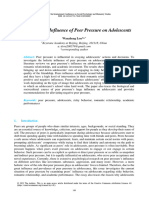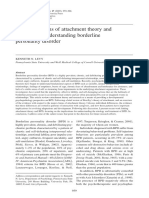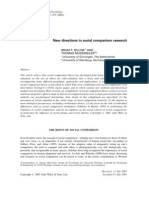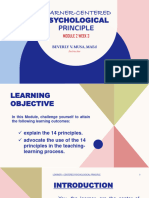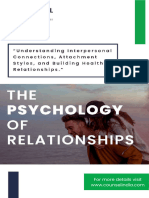Self Esteem Final
Self Esteem Final
Uploaded by
api-286139661Copyright:
Available Formats
Self Esteem Final
Self Esteem Final
Uploaded by
api-286139661Original Title
Copyright
Available Formats
Share this document
Did you find this document useful?
Is this content inappropriate?
Copyright:
Available Formats
Self Esteem Final
Self Esteem Final
Uploaded by
api-286139661Copyright:
Available Formats
Running head: INSIGHT INTO SELF-ESTEEM
Insight into Self-Esteem
Jessica Marie Sitton
College of DuPage
INSIGHT INTO SELF-ESTEEM
2
Abstract
Self-esteem has grown into an extensive problem, not just in the United States, but also
all over the world. There have been multiple studies done mostly on women and children, but
also on men explaining the causes and effects of low self-esteem. Not only have there been
multiple studies explaining self-esteem, but there are multiple theories. The studies reviewed
concluded self-perception verse reality through the media, body dissatisfaction through
advertising and the media, impact on lifestyle choices, and the effects on mental health.
INSIGHT INTO SELF-ESTEEM
3
Insight into Self-Esteem
Everyone has self-esteem and it is very important to gain insight about the affects it has
on someone. It has been seen and researched that those who experience low self-esteem live life
a lot differently than those with high self-esteem. There are many factors in the 21st century that
play a role in low self-esteem. These factors affect people daily and is part of the cause of why
people seem to be so unhappy. Those with low self-esteem are critical on themselves by viewing
themselves through the eyes the culture sets to be the ideal look. There are multiple theories to
explain why everyone has self-esteem and what causes it. Some of the factors that play a role is
the media, technology, and advertising causing body dissatisfaction. Self-esteem impacts life
style choices, which is caused by our failures and successes. Those with low self-esteem find it
harder to fit in, hard to keep the relationships they have, have more health risks, affects them
socially, and much more. Self-esteem has spread to become a tremendous problem all over the
world.
Overview
Self-esteem and body dissatisfaction had grown to become an immense issue and gained
more interest over the past 20 to 30 years. Many studies have been done on students, but the
main focus is looking at women and children. There are further studies being done on
children for the fact that eating disorders start very early on after puberty and through high
school. Not only have there been studies locally, but also cross-culturally. Self-esteem and body
dissatisfaction is a universal problem in areas such as: Hong Kong, Norway, Poland, and
multiple minority groups in Western countries. (Furnham, Badmin, & Sneade, 2002). Selfesteem is a huge topic that is important to understand. People are complimented and criticized
each day, but find it hard to hear and connect that information to their self-esteem. The
INSIGHT INTO SELF-ESTEEM
correlation between the fluctuation in our emotions and self-esteem is the causes of major
failures and successes throughout someone's life. (Baumeister, Campbell, Krueger, & Vohs,
2003).
Baumeister, Campbell, Krueger, and Vohs (2003) states, self-esteem has moved from an
individual concern to more of a societal concern. The psychological claim is, "North American
society in particular has come to embrace the idea that high self-esteem is not only desirable in
its own right, but also the central psychological source from which all manner of positive
behaviors and outcomes spring (p.3)." This claim has passed through to become what most
people believe. In contrast, low self-esteem is the source for problems and dysfunctions for both
society and individuals in which interventions should occur.
According to Heatherton, Wyland, and Lopez (2003), having high self-esteem is
beneficial for how those live their lives and how they feel. Those who possess high self-esteem
cope well in different situations. They tend to be happier with themselves leading to a very social
and productive lifestyle. While, those with low self-esteem live the complete opposite lifestyle.
They view everything around them and themselves negatively. Low self-esteem can lead to more
serious health problems such as, "substantial evidence shows a link between self-esteem and
depression, shyness, loneliness, and alienation (p.219)." The link between low self-esteem and
these emotional or behavioral problems could be associated with a lot of different aspects in life.
Within adolescents it is more focused on behavioral concerns, but they could also experience
negative emotions. It is very important for adolescents to have high self-esteem when they are
developing their behavior. As it may be seen everywhere, adolescents acting out, involved in
drugs, or not performing well in school can all be correlated with low self-esteem. A preventative
is to find social support, but those who have low self-esteem are less likely to seek out and
INSIGHT INTO SELF-ESTEEM
receive the support from those around them. Many schools may open more programs or clubs
being the idea that, high self-esteem would act something like a social vaccine (p.219), by
gaining the support from others it may be a preventative for the behavioral problems adolescents
may face. (Heatherton, Wyland, & Lopez, 2003, p. 219-220).
Theories
Mead's Theory
Significant others play a big role
with symbolic interactionism
helping internalize ideas and
attitudes.
The looking glass self: self
appraisals grow through social
surroundings (interacting with others
and perceptions of others).
Cooley's Theory
Theories
Terror Management Theory
From our evolutionary history
human beings have a crucial need
to belong for survival.
How people connect and value
groups within their culture to help
with having less worry and fear.
Sociometer Theory
Figure 1 A matrix laying out the different type of theories to explain self-esteem.
There are many theories to explain self-esteem as shown in figure 1, but the most popular
theories come from Cooley and Mead. Cooleys theory is defining the looking glass self, which
is, self-appraisals are viewed as inseparable from social milieu (p.221). While, Meads theory
explains, symbolic interactionism outlined a process by which people internalize ideas and
attitudes expressed by significant figures in their lives (p.221). Based off of Cooley and Mead,
people view themselves based off of their surroundings and the responses they seek from those
who mean the most to them. People acquire low self-esteem if those who have the most
significance to them tend to reject, ignore, or do not give any value to that person. (Heatherton,
Wyland, & Lopez, 2003, p. 221).
INSIGHT INTO SELF-ESTEEM
Another theory states that self-esteem arises from evolution. Leary, Tambor, Terdal, and
Downs have proposed the sociometer theory, stating, "humans have a fundamental need to
belong that is rooted in our evolutionary history (p.222)." As we have learned in many classes
that the basic need for survival is to be associated with a group. Those who found a group were
more likely to survive than those who were excluded and on their own. The sociometer theory is
the scale of social exclusion. Those who have an increase in rejection from those around them
experience low self-esteem, because they are not fitting in. On the opposite scale, those with high
self-esteem find rejection to be very low and worry less about how others view them. This theory
has been found to correlate low self-esteem with social anxiety. (Heatherton, Wyland, & Lopez,
2003, p. 221-222).
The terror management theory is another insight about self-esteem. This theory explains
how people tend to connect and value the groups within the same culture for two main reasons.
Literal immortality, which defines the religious beliefs about death. Symbolic immortality,
meaning being a part of a group whose existence tolerates with death. Both help with not being
fearful and help cope with death. Not having as many worries or fears will help gain a higher
self-esteem, explaining why not being afraid of death and being a part of a culture that
understands those values. (Sowislo & Orth, 2013).
Self-Perception vs Reality (Media)
Today the new and improved technology over the years is consuming lives. The internet
can be accessed by children in 70 million households. The internet along with the new
technology has made a tremendous impact on decreasing adolescents social skills with others,
which gaining new relationships is important to develop throughout a childs life. There is a lot
with communication that children need to learn such as, "social competence and self-control,"
INSIGHT INTO SELF-ESTEEM
which is talking about self-esteem, social anxiety, aggression control, and general social skills, in
order to feel comfortable and perform in social settings (p.1). The internet provides positive and
negative opportunities with providing communication through chat and virtual worlds, but also
presenting entertainment and the news. Just like the internet, television plays a role in the way
children learn behavior. One problem with the internet is falsely identifying oneself about their
demographics, which could cause problems with social skills and self-esteem in reality.
(Harman, Hansen, Cochran, & Lindsey, 2005, p. 1).
Studies have been done to find the impact between the frequency in the use and faking
behaviors on the internet. There was a negative correlation for the amount of time spent on the
internet with affecting social skills. A positive correlation was found for those who are faking
who they really are on the internet with developing low self-esteem, high social anxiety, poor
social skills, and higher aggression. Those misrepresenting themselves and staying anonymous
on the internet are threatening their social skills by not developing face-to-face interactions. They
tend to escape face-to-face communication for a few reasons being, "escaping inevitable social
anxieties by submerging themselves into their on-line persona, interacting in a fantasized world
with less restraint, and utilizing fewer opportunities to overcome such anxieties (p. 4)." When
they are offline these factors could cause more problems when they have to interact with others.
They may show more of a deserted behavior, which causes them to not show any individuality
and they may have more aggression. Creating a fake identity helps those with low self-esteem
feel better about themselves through the fake person they have created to be instead of loving
who they are in real life. Over the long run this could cause their self-esteem to increase.
(Harman, Hansen, Cochran, & Lindsey, 2005, p. 4).
Body Image
media exposing the
thin ideal
Social Comparison
Self-discrepancy
Negative psychological
outcomes: weight
concerns, depression,
mood, self esteem
INSIGHT INTO SELF-ESTEEM
Figure 2. Explaining self-discrepancy is a moderator in the relationship between the thin ideal
media exposure and negative psychological outcomes by social comparison. Adapted from can
the media affect us? Social comparison, self-discrepancy, and the thin ideal by Baumeister, R.F.,
Krueger, J.I., & Vohs, K. D. (2003). Psychological Science in the Public Interest (WileyBlackwell), 4(1), 1-44.
As in figure 2 explains, body dissatisfaction is negatively evaluating the body and has
been found that the effects of the thin ideal seen in the media has great exposure on body esteem,
weight satisfactions, and depression. Thin ideal internalization has to do with accepting the social
standards society has set for the ideal thinness. Both body dissatisfaction and thin ideal
internalization has to do with accepting the social standards culture has set through the media for
the ideal thinness. They both have come from social comparison, which is comparing ones body
to others and assessing the level of comparison. The media has a strong effect on women causing
negativity about themselves to occur, creating body dissatisfaction and possibly eating disorders
to appear. (Bessenoff, 2006).
A theory to explain low self-esteem based on viewing oneself is, self-discrepancies are
representations in the self-concept of ways in which one falls short of some important standard
(p.240). Someone with high levels of emotional distress is linked to high self-discrepancy,
which includes disappointment and dissatisfaction, feelings of shame, low self-esteem, clinical
depression, and social phobias. The link between self-discrepancy and emotional vulnerabilities
is the cause for eating disorders. Eating disorders along with other emotional disorders can
become very serious. It has been found that all the different disorders have a causal relationship
between long term exposure to the thin ideal that is portrayed in the media and developing selfdiscrepancies. (Bessenoff, 2006, p. 240).
INSIGHT INTO SELF-ESTEEM
Another theory to explain body dissatisfaction caused through the media is social
comparison. It states, we seek to compare ourselves to others we believe are similar to
ourselves, particularly to determine our own levels of abilities and successes (p.239-240).
Downward social comparison explains those who compare themselves to those who they see is
less fortunate than they are to help enhance their mood and feelings of self-worth. Upward social
comparison stats, comparison to others we perceive to be socially better than ourselves,
generally leads to negative mood and can threaten self-evaluation (p.240). When differences
appear between oneself and the standard ideal, people start to become more motivated to
improve how they look. It has been found by Stormer and Thompson that women who compare
themselves to others are more likely to gain negativity about themselves and create higher levels
of body dissatisfaction. In the study of social comparison to thin models, both adolescent girls
and college-aged women suffered increased negative mood, greater body dissatisfaction and
eating disorder symptoms, as well as diminished beliefs of their own physical attraction than
controls who did not explicitly compare (p.240). Media has a negative effect on women with
exposing the thin-ideal. (Bessenoff, 2006, p. 239-240).
Advertising
Advertising industries are unwilling to change their approach of using very thin models
on products because that is what brings the industries money. "The argument against using larger
models is that thinness sells, whereas fatness does not (p.105)." It is all about the looks, and
the thin ideal, but there is a point where someone is too thin. Statistics have showed that
skinny sells and makes the business they are promoting more money. (Halliwell & Dittmar,
2004, p. 105). Are advertisements in the media portraying women to be too thin? The models are
over represented compared to the actual population size of women to show a small group has the
INSIGHT INTO SELF-ESTEEM
10
"thin" ideal body size and all women should look that way. It is said, "womens ideal body
weight as depicted in magazines has decreased over the last 40 years, so that the average model
now is more than 20 percent underweight (p.105)." This thin ideal has put a lot of criticism on
the average women. The decreasing size of women portrayed in the media has increased the
levels of dissatisfaction and eating disorders in women. (Halliwell & Dittmar, 2004, p. 105).
Dove-Beauty Project
As people know the company Dove sells beauty products for women and in 2004 the
company launched their real beauty campaign. It was all about showing the real beauty behind
women, and not selecting models for the advertisement. The women they have chosen for the
advertisement were all different from each other in the fact that they were in their twenties and
thirties, multiracial, and they all had their own unique looks. (Johnston & Taylor, 2008)
Women will always be the biggest critics on themselves. Dove first took the approach of
posting images of women all over their website and on billboards to ask the publics opinion on
how they look. Dove was trying to show how critical women are on themselves and how others
view each other. With this campaign Dove wanted to express the concern on the ideal beauty
portrayed in the media today. Dove's website stated, "For too long, beauty has been defined by
narrow, stifling stereotypes. You've told us it's time to change all that. Dove agree. We believe
real beauty comes in many shapes, sizes, and ages. That is why Dove is launching the Campaign
for Real Beauty (p. 952)." Once again the media and the models that are used in advertisement
give women more of a reason to be more critical on themselves causing low self-esteem. Dove
felt the need while trying to sell their products to use real women with flaws that are seen on
everyone to communicate the message that women should own who they are and feel more
beautiful. (Johnston & Taylor, 2008, p. 951-952).
INSIGHT INTO SELF-ESTEEM
11
The Dove Real Beauty Campaign and Self-Esteem Fund turned out to be a major success
in educating and inspiring women. It was amazing how much of a connection it made with
women and other organizations that "by 2005, Dove claimed to have already reached over
138,000 eight-to fourteen-year-old girls with programs like Uniquely ME! and Body Talk.
(p. 952)." Not only had it reached out to other organizations, but it also made it into the arts in a
photography exhibition named, "Beyond Compare." It reached out all over the world in which
the photographers were from twenty two different countries. "The exhibition featured images of
women of various races and nationalities, including those portraying obesity, aging, dwarfism,
eating disorders, lesbians, and female body builders (p. 952)." With these images, Dove was able
to show the public these photographs to portray real beauty and then Dove would donate to the
"National Eating Disorder Information Centre." (Johnston & Taylor, 2008, p. 952-953).
Impact on Life Style Choices
Many people believe body dissatisfaction only occurs with women, but men also have
this problem as well. Women tend to describe themselves as fat, weigh themselves more, diet
frequently, and are more dissatisfied with their physical appearance more than men do. The
biggest difference between the two genders is dissatisfaction with weight and the shape of their
body, mainly in the hip region. Men and women are always comparing themselves to the
standard ideal weight set by the media. With this women tend to judge themselves as being
overweight, while men judge themselves to be underweight. What is the right weight? People are
always judging themselves to an unhealthy weight standard from what they see all over the
media and wanting to be just like the models, actors, actresses, etc. (Furnham, Badmin, &
Sneade, 2002)
INSIGHT INTO SELF-ESTEEM
12
As reported by authors Furnham, Badmin, and Sneade (2002), Western society focus on
dieting and exercise to alter the body. Exercising has become a normative behavior for men and
women, but is it for the right reasons? Research has been done to give evidence that it is, "dieting
behavior that is an important factor in the development and perpetuation of eating disorders
(p.584)." Exercise has been seen in two ways. One being to quicken the amount of time it takes
for someone to lose weight. Second, a reason for people who are dieting to deny how unpleasant
it may be. There has been a correlation that dieting and exercise is one risk for eating disorders.
Those who exercise for their appearance and not for health reasons may also be at risk for
developing an eating disorder. What are the positive and negative connections to exercise and
eating disorders? For both genders, exercising for weight, tone, and attractiveness is positively
connected to body image dissatisfaction and eating disorders. While, exercising for fitness is the
opposite effect. These two correlations along with research come to the conclusion that certain
motivations for exercising increase disturbances, like body dissatisfaction and self-esteem.
Eating disorders and body dissatisfaction is not always seen in men because we hear so
much about it with women. There has been some evidence to prove eating disorders are
increasing in men. Men do not want to talk about how they are feeling and about the problems
they are facing because it is how society and our culture brings up adolescent boys. There has
been more research and talk about self-esteem and eating disorders in women, which may
discourage men even more to admit to something that is classified as a female disorder. The
labeling behavior is also different between men and women with the amount of food they take in.
With men a large quantity of food is not labeled whereas with women they may label it to be
bingeing. (Furnham, Badmin, & Sneade, 2002).
Rejection
INSIGHT INTO SELF-ESTEEM
13
Adolescents with low self-esteem can be very hard to deal with especially for those who
are always feeling like they do not belong and are being rejected by their peers. It is important
for those to seek help because the adolescents that are being rejected and not fitting in experience
multiple types of negative affective states and physical illness. (Heatherton, Wyland, & Lopez,
2003). Peer groups play a big role in a child's life especially teenagers. They have become more
important than the role of their parents because being accepted into a peer group gives out more
social opportunities to teenager. Those opportunities develop social skills and create the feeling
of social belonging. Peer rejection creates stress because being rejected means there are less
chances to create social interactions with others and lowers the sense of belonging. Rejection
early on in life causes multiple problems, including emotional disorders, poor academic
performance, aggression, and antisocial behaviors. Not only does rejection cause emotional and
behavioral disorders, but it also causes materialism. (Jiang, Zhang, Ke, Hawk, & Qiu, 2015).
Peer rejection causes materialism because the possessions people own defines how they
are seen by others. There are three reasons for materialism. One being it has been seen day to day
and reported that, "adolescents are inclined to judge their peers on the number and quality of
their possessions (p. 49)." For this reason if adolescents are being rejected, they are more likely
wanting and owning these materialistic possessions because of peer pressure. They feel owning
these possessions will help them fit in with a group, gain more friendships, and not feel like an
outsider. Second, materialism provides individuals for a short time a sense of economic safety
and self-identity, which is said to, "restore the psychological security undermined by peer
rejection (p.49)." Lastly, it is believed that these possessions can take place of relationships with
others. (Jiang, Zhang, Ke, Hawk, & Qiu, 2015, p. 49).
INSIGHT INTO SELF-ESTEEM
14
There are many benefits that come along with materialism which are, "facilitation of
affiliation, restoration of security, substitution for interpersonal relationships, and mood repair,"
along with increasing self-esteem (p.49). Low self-esteem correlates with rejection because they
are not feeling accepted by their peers and begin to feel self-doubt. Those who experience more
rejection and create fear of becoming accepted by others tend to spend more on materialistic
possessions to help with the feeling of low self-esteem. Materialism and low self-esteem are
positively correlate for multiple reasons being, "belonging motivation, self-doubt and
uncertainty, public self-consciousness and social anxiety, interpersonal and personal insecurity,
and desires for self-enhancement (p.49)." These findings of materialism are a way to cope with
low self-esteem in the short run, but in the long run may start to reduce their self-esteem once
again. (Jiang, Zhang, Ke, Hawk, & Qiu, 2015, p. 49).
Outcomes of Self-Esteem
Authors Orth, Robins, and Widaman (2012), found self-esteem to be positively correlated
with relationships. Those with high self-esteem find it easy to make and keep new relationships
for the reason they show more relationship enhancing behaviors. For those with low self-esteem,
they reduce the amount of relationships they have and do not seek out to find new ones because
they are sensitive to rejection. Not only does self-esteem affect relationships, but in contrast
relationships can affect self-esteem. Those who are in enjoyable and close relationships will tend
to have higher self-esteem.
One would never think self-esteem would have to do with occupational status or salary,
but it is found to have a positive correlation. Both of this areas of occupational status and salary
have to do with socioeconomic status within society. Both influence someone's self-esteem for
how well they are doing and how much they are gaining within their occupation. The other way
INSIGHT INTO SELF-ESTEEM
15
around may be those with a higher self-esteem obtain a higher education allowing them to
become more successful throughout their career. (Orth, Robins, & Widaman, 2012).
Those with a higher self-esteem were reported to have better physical health because
they, "seek and receive more social support, experience less stress, and show more adaptive
coping behaviors (p. 273)." Not only does it have to do with seeking out the help to stay healthy,
but those with a higher self-esteem tend to be more independent and contribute more to society,
causing their self-esteem to increase. Studies have found that self-esteem has a positive
correlation with people's health. As an example, a study done by Trzesniewski, found, "low selfesteem in adolescence predicted more physical health problems at age 26 (p. 273)." (Orth,
Robins, & Widaman, 2012, p. 273).
In the study by, Orth, Robins, and Widaman (2012), self-esteem is a predictor and a risk
of depression. They have found that low self-esteem on depression can occur over a short period
of time, but also over a long period of time. Depression caused from low self-esteem can happen
to anyone, if you are a man or a women or if you are young or old. It has been found that low
self-esteem is more of a consequence of depression and is not necessarily the cause.
Mental Health
Depression can be severe and is a major health concern universally. It affects a wide
range of the population in multiple ways. Depression is different for everyone and there are
multiple ranges of depression. "It is associated with impaired functioning in the relationship,
work, health domain, and with elevated rates of suicidal behavior (p. 215)." (Sowislo & Orth,
2013, p. 215-216).
There are a lot of theories explaining self-esteem and the important role it has on
someone's life. Low self-esteem is more of a form of depression, but is not the same disease as
INSIGHT INTO SELF-ESTEEM
16
depression. It is a bit difficult to diagnose someone with depression if their only symptom is
feeling worthless or thinking bad about themselves. In order to diagnose someone successfully
with a disease as severe as depression there needs to be more criteria. Self-esteem is one
symptom of depression, but it also a symptom for other cases, which include: learning disorders,
stuttering, social phobia, and attention deficit. (Sowislo & Orth, 2013).
Discussion
Why are people found to be so unhappy in the 21st century? There are many factors that
play a in the 21st century that are creating low self-esteem to become a huge issue cross
culturally. Self-esteem has been around ever sense people were around and there are many
theories to explain the concept of self-esteem. Some of the factors causing low self-esteem are
the media, advertising, and rejection. These factors cause body dissatisfaction and changing
peoples lifestyles. They are causing people to not have a sense of belonging. Which, a lot of
times low self-esteem turns into other health risks, emotional fluctuations, or effects the mental
health. Low self-esteem could become very serious and it is important to understand the impact it
has on someones life.
INSIGHT INTO SELF-ESTEEM
17
References
Ata, R. N., Ludden, A. B., & Lally, M. M. (2007). The effects of gender and family, friend, and
media influences on eating behaviors and body image during adolescence. J Youth
Adolescence, 1024-1037. http://dx.doi.org/10.1007/s10964-006-9159-x
Baumeister, R. F., Campbell, J. D., Krueger, J. I., & Vohs, K. D. (2003). Does high self-esteem
cause better performance, interpersonal success, happiness, or healthier lifestyles?
Psychological Science in the Public Interest (Wiley-Blackwell), 4(1), 1-44.
http://dx.doi.org/10.1111/1529-1006.01431
Bessenoff, G. R. (2006). Can the media affect us? Social comparison, self-discrepancy, and the
thin ideal. Psychology of Women Quarterly, (30), 239-251.
Curtis, C., & Loomans, C. (2014). Friends, family, and their influence on body image
dissatisfaction. Women's Studies Journal, 28(2), 39-56.
Furnham, A., Badmin, N., & Sneade, I. (2002). Body image dissatisfaction: Gender differences
in eating attitudes, self-esteem, and reason for exercise. The Journal of Psychology:
Interdisciplinary and Applied, 136(6), 581-596.
http://dx.doi.org/10.1080/00223980209604820
Halliwell, E., & Dittmar, H. (2004). Does size matter? The impact of model's body size on
women's body-focused anxiety and advertising effectiveness. Journal of Social and
Clinical Psychology, 23(1), 104-122. http://dx.doi.org/10.1521/jscp.23.1.104.26989
Harman, J. P., Hansen, C. E., Cochran, M. E., & Lindsey, C. R. (2005). Liar, liar: Internet faking
but not frequency of use affects social skills, self-esteem, social anxiety, and aggression.
CyberPsychology and Behavior, 8(1), 1-6. http://dx.doi.org/10.1089/cpb.2005.8.1.
INSIGHT INTO SELF-ESTEEM
18
Heatherton, T. F., Wyland, C. L., & Lopez, S. J. (2003). Assessing self-esteem. Positive
Psychological Assessment: A Handbook of Models and Measures., 219-233.
Jiang, J., Zhang, Y., Ke, Y., Hawk, S. T., & Qiu, H. (2015). Can't buy me friendship? Peer
rejection and adolescent materialism: Implicit self-esteem as a mediator. Journal of
Experimental Social Psychology, 58, 48-55. http://dx.doi.org/10.1016/j.jesp.2015.01.001.
Johnston, J., & Taylor, J. (2008). Feminist consumerism and fat activists: A comparative study of
grassroots activism and the dove real beauty campaign. Journal of Women in Culture and
Society, 33(4), 941-966.
Orth, U., Robins, R. W., & Widaman, K. F. (2012). Life-span development of self-esteem and its
effects on important life outcomes. PsycARTICLES, 102(6), 1271-1288.
http://dx.doi.org/10.1037/a0025558
Sowislo, J. F., & Orth, U. (2013). Does low self-esteem predict depression and anxiety? A metaanalysis of longitudinal studies. Psychological Bulletin, 139(1), 213-240.
http://dx.doi.org/10.1037/a0028931
Williams, N. A., Fournier, J., Coday, M., Richey, P. A., Tylavsky, F. A., & Hare, M. E. (2012).
Body esteem, peer difficulties and perceptions of physical health in overweight and obese
urban children aged 5 to 7 years. Child: Care, Health and Development, 825-835.
http://dx.doi.org/10.1111/j.1365-2214.2012.01401.x
You might also like
- Archangel Michael Oracle GuidebookDocument30 pagesArchangel Michael Oracle Guidebookfrancesca100% (1)
- Some Antecedents and Consequences of Social-Comparison JealousyDocument13 pagesSome Antecedents and Consequences of Social-Comparison JealousyMakanudo.No ratings yet
- Influence of Social Media On Self PerceptionDocument13 pagesInfluence of Social Media On Self PerceptionOlaotse MoletsaneNo ratings yet
- Understanding Self Module 1Document17 pagesUnderstanding Self Module 1Vipul Chauhan87% (39)
- The Impact of Social Media Volume and Addiction On Medical StudentsDocument12 pagesThe Impact of Social Media Volume and Addiction On Medical StudentsIan Kristopher Bayan100% (1)
- Mixed Method Reasearch On Social Media in The Influence of DepressionDocument57 pagesMixed Method Reasearch On Social Media in The Influence of DepressionLlordie MontecarloNo ratings yet
- Eradicating Cyber Bullying: Through Online Training, Reporting & Tracking SystemFrom EverandEradicating Cyber Bullying: Through Online Training, Reporting & Tracking SystemRating: 5 out of 5 stars5/5 (1)
- Building Self EsteemDocument3 pagesBuilding Self EsteemAnonymous jlLBRMAr3O100% (1)
- Self-Esteem and Relationship SatisfactionDocument46 pagesSelf-Esteem and Relationship Satisfactionchocksc-am20No ratings yet
- The Effect of Social Media On The Physical Social Emotional andDocument30 pagesThe Effect of Social Media On The Physical Social Emotional andAdriana MeloNo ratings yet
- Research On The Influence of Peer Pressure On AdolDocument7 pagesResearch On The Influence of Peer Pressure On AdolVy HàNo ratings yet
- Final 608 Proposal-NewDocument10 pagesFinal 608 Proposal-Newapi-489701248No ratings yet
- SG Youth Mental Health Social Media AdvisoryDocument25 pagesSG Youth Mental Health Social Media AdvisoryF HNo ratings yet
- Investigating The Relationship Between Attachment Styles, Self-Efficiency and Academic Performance of High School Students of Zahedan CityDocument5 pagesInvestigating The Relationship Between Attachment Styles, Self-Efficiency and Academic Performance of High School Students of Zahedan CityTI Journals PublishingNo ratings yet
- Review of Related Literature Effect of Social Media On StudentDocument6 pagesReview of Related Literature Effect of Social Media On StudentJames GabatinoNo ratings yet
- Self EsteemDocument14 pagesSelf EsteemlorrainemalbaNo ratings yet
- Berger 2007Document37 pagesBerger 2007efunctionNo ratings yet
- HSC 421 Research PaperDocument13 pagesHSC 421 Research Paperapi-502687231No ratings yet
- Social Media and Academic PerformanceDocument81 pagesSocial Media and Academic PerformanceJayzel Lopez0% (1)
- The Impact of Social Media On Self EsteemDocument1 pageThe Impact of Social Media On Self EsteemMcQueen 18No ratings yet
- Impact of Social Media June 2023Document54 pagesImpact of Social Media June 2023Prince Charles AriolaNo ratings yet
- Research Paper Coping Mechanism of SHS 2022Document29 pagesResearch Paper Coping Mechanism of SHS 2022Lexter PapauranNo ratings yet
- The Effect of Social Media On TeenagersDocument3 pagesThe Effect of Social Media On TeenagersKarol Sanchez100% (1)
- CyberbullyingDocument8 pagesCyberbullyingQUINTILLA ALEXXA YNA MARINo ratings yet
- Cyberbullying and Self-EsteemDocument9 pagesCyberbullying and Self-EsteemDantrsNo ratings yet
- Attachement Parentyng Styles PDFDocument6 pagesAttachement Parentyng Styles PDFOvidiu BerarNo ratings yet
- Group 2 Research 11 1Document18 pagesGroup 2 Research 11 1Nina Delos reyesNo ratings yet
- The Impact of Cyberbullying To The Mental Health of The Grade 12 AbmDocument19 pagesThe Impact of Cyberbullying To The Mental Health of The Grade 12 AbmSerene RiegoNo ratings yet
- Effect of BullyingDocument11 pagesEffect of BullyingAnonymous 2ch6hSNo ratings yet
- BULLYINGDocument38 pagesBULLYINGRM ValenciaNo ratings yet
- The Effects of Social MediaDocument14 pagesThe Effects of Social MediaJasmine Pajarillo NagasNo ratings yet
- CyberbullyingDocument6 pagesCyberbullyingapi-335565217No ratings yet
- Research Ni TotoyDocument39 pagesResearch Ni TotoyJames Ryan DelarosaNo ratings yet
- Sanchez Mira School of Arts and Trades Senior High SchoolDocument13 pagesSanchez Mira School of Arts and Trades Senior High SchoolKim Charlotte Balicat-Rojo ManzoriNo ratings yet
- RRLDocument15 pagesRRLLorelyn TriciaNo ratings yet
- Parenting Styles of ParentsDocument13 pagesParenting Styles of ParentsArlene L PalasicoNo ratings yet
- RRLDocument10 pagesRRLDo FernanNo ratings yet
- Effects of Social Media On Academic PerformanceDocument9 pagesEffects of Social Media On Academic PerformanceJevaughn SmallNo ratings yet
- Impact of Social Media On Academic Performance of Graduate Students in KathmanduDocument13 pagesImpact of Social Media On Academic Performance of Graduate Students in Kathmanduchlyde numancieNo ratings yet
- Review of Related LiteratureDocument8 pagesReview of Related LiteratureSheena Namuco100% (1)
- RRL Facebook and Self EsteemDocument7 pagesRRL Facebook and Self EsteemViola Hastings0% (1)
- Levy 2005Document28 pagesLevy 2005Daniela StoicaNo ratings yet
- The EffectDocument5 pagesThe EffectRoy Jerald BancolitaNo ratings yet
- Banning of SmartphoneDocument19 pagesBanning of SmartphoneEllen Grace LingonNo ratings yet
- Fowler Thesis 2015Document76 pagesFowler Thesis 2015Isaiah Samuel De GraciaNo ratings yet
- Chapt 1 5 Need Edit NG Conrec at Chapt5Document42 pagesChapt 1 5 Need Edit NG Conrec at Chapt5marilou tanNo ratings yet
- Level of Self-Esteem As Correlates To Social Media Exposure Among BS Psychology Students of Lyceum of Subic Bay A.Y 2022-2023Document12 pagesLevel of Self-Esteem As Correlates To Social Media Exposure Among BS Psychology Students of Lyceum of Subic Bay A.Y 2022-2023Psychology and Education: A Multidisciplinary JournalNo ratings yet
- Research Paper Final Draft Kyli PytelDocument16 pagesResearch Paper Final Draft Kyli Pytelapi-533689619No ratings yet
- Social Comparison ResearchDocument9 pagesSocial Comparison Researchdinu_adercaNo ratings yet
- Body Shaming As The Name SuggestsDocument3 pagesBody Shaming As The Name Suggestsjhamel quiatchonNo ratings yet
- A Review of The Research On Internet Addiction PDFDocument27 pagesA Review of The Research On Internet Addiction PDFSai RamNo ratings yet
- Annotated Biblograpy Engl 102Document6 pagesAnnotated Biblograpy Engl 102api-315075269No ratings yet
- High School BullyingDocument24 pagesHigh School BullyingtoxictouchNo ratings yet
- Parental Attachment, Peer Attachment and Secondary Students Behaviour in MalaysiaDocument88 pagesParental Attachment, Peer Attachment and Secondary Students Behaviour in Malaysianur madihahNo ratings yet
- Adolescent Development The Impact of Peer RelationshipDocument9 pagesAdolescent Development The Impact of Peer Relationshipapi-664310702No ratings yet
- Cyber - Bullying FinalDocument20 pagesCyber - Bullying FinalNeeraj Sharma100% (1)
- The Effect of Social Media On Self Esteem Real OneDocument10 pagesThe Effect of Social Media On Self Esteem Real Oneapi-405925497No ratings yet
- Peer Pressure DraftDocument14 pagesPeer Pressure DraftRamil HernandezNo ratings yet
- Pasaway Research-Chapter 1-5Document24 pagesPasaway Research-Chapter 1-5Karen Roldan Rosalejos100% (1)
- A Comparative Study On Social MediaDocument8 pagesA Comparative Study On Social MediaBerk TekinNo ratings yet
- Literature Review On Impact of Social Media On YouthDocument6 pagesLiterature Review On Impact of Social Media On Youthc5nrmzsw100% (1)
- 1740 Seminar Sem IxDocument17 pages1740 Seminar Sem IxMEHULANo ratings yet
- Alternate Route to School Effectiveness and Student Achievement: Circumventing Socioeconomic StatusFrom EverandAlternate Route to School Effectiveness and Student Achievement: Circumventing Socioeconomic StatusNo ratings yet
- WPA-Sample-Principles of Occupational Safety & HealthDocument34 pagesWPA-Sample-Principles of Occupational Safety & HealthSachi Anand100% (1)
- Unit 1 - Self Assessment Questions: Your Last Recorded Submission Was On 2021-09-27, 19:14 ISTDocument54 pagesUnit 1 - Self Assessment Questions: Your Last Recorded Submission Was On 2021-09-27, 19:14 ISTHeet Rathod50% (2)
- Situation Reasons Effect Reaction AdviceDocument11 pagesSituation Reasons Effect Reaction AdviceMariel Samonte VillanuevaNo ratings yet
- Prosperityseries PDFDocument263 pagesProsperityseries PDFkosovare3100% (1)
- Relationship of Cosmetics To SelfDocument4 pagesRelationship of Cosmetics To SelfChristianieAnn100% (1)
- 1995 Rosenberg Et Al - Global and Specific Self EsteemDocument17 pages1995 Rosenberg Et Al - Global and Specific Self EsteemnebunikandreeaNo ratings yet
- Danger 1 Dangerous SelfiesDocument3 pagesDanger 1 Dangerous SelfiesYasmin LopezNo ratings yet
- PCK 1 Module 2 Week 3 LCPDocument28 pagesPCK 1 Module 2 Week 3 LCPCharlene Mae de leonNo ratings yet
- 10 1108 - Er 01 2016 0014Document15 pages10 1108 - Er 01 2016 0014Sayed AminNo ratings yet
- Design Intermediate VolumeDocument208 pagesDesign Intermediate VolumefidelitycomfortNo ratings yet
- Too Much Homework Causes DepressionDocument8 pagesToo Much Homework Causes Depressiong3z365gm100% (1)
- Learning Task. The Best Version of Me: Presentado Por: Deisy Alejandra Henao DíazDocument4 pagesLearning Task. The Best Version of Me: Presentado Por: Deisy Alejandra Henao Díazdeisy alejandra henaoNo ratings yet
- Psychology of Human RelationshipsDocument40 pagesPsychology of Human RelationshipsCounsel IndiaNo ratings yet
- Consumer Impulse Buying Behavior - The Role of Confidence As Moderating EffectDocument12 pagesConsumer Impulse Buying Behavior - The Role of Confidence As Moderating EffectNunung lfiahNo ratings yet
- Presentation HowtoorganizeSPORTSCLUBDocument104 pagesPresentation HowtoorganizeSPORTSCLUBThem poll CeloricoNo ratings yet
- INTRODUCTIONDocument18 pagesINTRODUCTIONRmaNo ratings yet
- Book Summary - The Subtle Art of Not Giving A F - CK by Mark MansonDocument12 pagesBook Summary - The Subtle Art of Not Giving A F - CK by Mark Mansonrt122001167% (3)
- Passing It On - Growing Your Future Leaders - Munroe, MylesDocument307 pagesPassing It On - Growing Your Future Leaders - Munroe, MylesBeatrice Mathew100% (1)
- Management of Chronic and Terminal IllnessDocument12 pagesManagement of Chronic and Terminal IllnessANJALI EMMANUALNo ratings yet
- 34 - Lifespan - Bandura and Ruby PayneDocument5 pages34 - Lifespan - Bandura and Ruby Payneabeeramee subramaniamNo ratings yet
- Worksheet # 2 - Looking Glass SelfDocument3 pagesWorksheet # 2 - Looking Glass SelfMa. Rema PiaNo ratings yet
- Kolej Tunku Kurshiah, Seremban Literature in Action 2021 Theme: Identities and RelationshipsDocument9 pagesKolej Tunku Kurshiah, Seremban Literature in Action 2021 Theme: Identities and RelationshipsAbd Fattah JamaluddinNo ratings yet
- SDO Angeles City CSE Modules Values Personhood March - 17 - 2022 - FINAL - COLORED 2Document24 pagesSDO Angeles City CSE Modules Values Personhood March - 17 - 2022 - FINAL - COLORED 2Ma Concepcion Adriano GuansingNo ratings yet
- Psychology: (9th Edition) David MyersDocument58 pagesPsychology: (9th Edition) David Myersapi-286605104No ratings yet
- Chapter - 1 The Problem and Its BackgroundDocument13 pagesChapter - 1 The Problem and Its BackgroundJESSEAL SANTIAGONo ratings yet
- Understanding The Self Part IVDocument20 pagesUnderstanding The Self Part IVAnne DahanNo ratings yet










